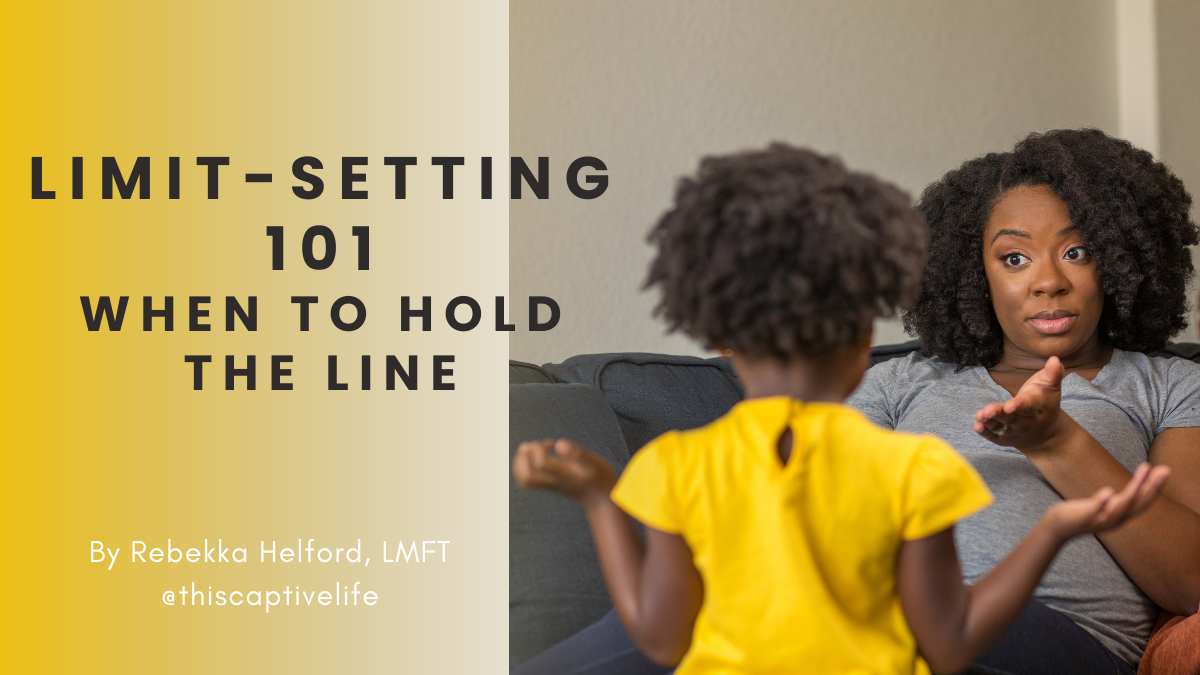Limit-setting 101: When to hold the line
In my post on the two hands of parenting, I talk about the importance of holding the line: setting limits or boundaries with our loved ones. However, for those of us who grew up in families that were not especially great at modeling how to set them, we may not have a good sense of when or how to set a clear, respectful limit.
Consider this post a primer on the basics of when to draw the line: not just with your children (although this is a great place to practice), but also with friends, family members, coworkers, romantic partners, etc. I'll discuss the hows of limit-setting in a separate post, so stay tuned!
What is a limit?
I recently heard a helpful metaphor describing a limit; it's like a beautiful garden wall. It's just there, an immovable object. It doesn't get upset if someone runs into it; why would it, it's a wall!
A limit lets someone else know what they may and may not do. It sets parameters and expectations for acceptable behavior in a given situation. It also speaks to our personal, cultural, and societal needs and desires. Limits may be global and rigid (e.g., you may never put your hand on a hot stove) or situational and flexible (e.g., in our home you may put your feet on the couch, but at grandma's house you may not).
You may set limits for a variety of reasons both personal and practical. Here are some of the main reasons when or why you might choose to set a limit. My examples have to do with children, but these limit-setting situations could apply to any human relationship.
When to set a limit
1. Safety:
This is the number one reason to set a limit with a child, and the kind of limit that most people will have no problem setting and enforcing. Safety limits are usually non-negotiable, although there are often some choices that can be offered in enforcing them. For example:
"I hear that you don't want to get into the carseat. The only safe place for children in the car is in the carseat - would you like to climb in by yourself or have me lift you in?"
"You may not cross the street by yourself. You must hold my hand or I will carry you. Okay, you're not taking my hand, so you're showing me you need me to carry you. I'll pick you up in one, two, three."
2. Health
This is also sort of a given. If children are sick and they need medicine, they need to take it. Children need to get plenty of sleep and enjoy a healthy diet. Again, we can acknowledge feelings that arise when we enforce a health-related limit, but most parents would have no qualms about the following type of scenario:
"It's time to go to the dentist - I know it's not always fun. It's really important to keep your teeth and mouth healthy. Which toy would you like to bring along with you?"
3. Values/Culture
This is where limit setting may vary widely, depending on who and where you are. In some families, it may be a hard limit that shoes are not worn in the house, or that food is not eaten in front of the television (if there is a television at all!).
Whatever your personal/family values, and whatever your cultural priorities, you absolutely have the right to set limits around these issues! You also have the right to acknowledge that these values may differ from family to family and home to home, and that your child may experience this difference as unfair or inequitable (I'm recalling a conversation from my teenage years about what would happen if all my friends decided to jump off a bridge...). Case in point:
"In our family, we don't bring toys to the dinner table. Let's find a safe place to leave them while we eat."
"Children need to use quiet voices in stores. If you can't find your quiet voice, that's okay, we'll just need to leave the store and go shopping another time."
These last two are where we get into the nitty gritty of parental preference and intuition. These are not hard and fast, rigid limit-setting situations. Rather, they are highly personal and will vary from occasion to occasion. People often have the greatest discomfort giving themselves permission to set these kinds of limits based on messages they've received, in addition to societal myths, about parenting.
So you're hearing it here, from me; you have permission to set limits based on convenience and willingness.
4. Convenience
Parenting is mostly a combination of panicking and googling, I often joke. That means that when option A is more convenient than option B, even if only marginally so, you can bet a reasonable sum that option A is going to be what's for dinner (or what's going to be that day's activity, etc.). There's a mediocre but serviceable Chinese restaurant near us that's right next door to an excellent Mexican place. The Chinese restaurant has a free and convenient parking lot, while the Mexican place is street parking only. Guess which one gets our business? Here's how setting a limit for convenience might sound:
"You'd really like to go to the beach park [yes, I do live in Southern California], but it's kind of far and it's getting near rush hour. That's going to be too tough of a trip today. Let's pick a closer park where we can play today, and plan another time to go to the beach park."
5. Willingness
Sometimes, whether due to exhaustion, frustration, sadness, or illness, among other things, we are just not up for a particular behavior or activity. This is truly parental discretion at its most subjective: "because I said so" for a kinder (and still firm) generation. Yes, you can make (seemingly) arbitrary decisions for your own reasons. And you can be transparent about those reasons while still acknowledging the other party's displeasure with the limit. For example:
"I'm not willing to let you watch another episode of Daniel Tiger's Neighborhood right now. You already got to watch one while mommy and daddy got ready for work. You may watch another one tomorrow. I know you got watch two episodes yesterday, and today I'm drawing the line at one."
Or even,
"You ate up all your pancakes and now you want my last one. Daddy's making you some more right now - I'm enjoying mine, so I'm going to finish it. I know it can be hard to wait when you really want something. Should we sing The Itsy Bisty Spider or Twinkle Twinkle while we wait?"
Yes, that's right - you absolutely don't have to give your child that last delicious pancake. I've heard it said that parenting is like being in an airplane; when those oxygen masks come down, you've got to put on your own mask first before you help your fellow passengers. If you haven't got enough oxygen, or pancakes, or patience, you're definitely not going to be able to be present and available with your fellow humans.
So put on your mask. Eat that last pancake. Fill yourself up so you have the fortitude to set a limit, for whatever important reason. Know that your fellow passenger might not like it, and set it kindly but firmly anyway.
(Actually, come to think of it, you may need more than one pancake for all of that.)
Rebekka Helford is a licensed marriage and family therapist in private practice in Los Angeles, California. With over a decade of experience working with parents and young children, Rebekka specializes in short-term intensive parenting consultation, using a variety of tools including home, office, and school visits to help families navigate developmental hiccups and get back on track. Virtual visits now available!
Click here to schedule an appointment or contact Rebekka with a question – who knows, she might even answer it in her next post!


